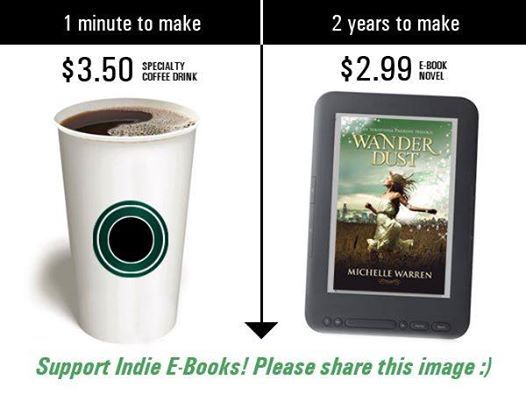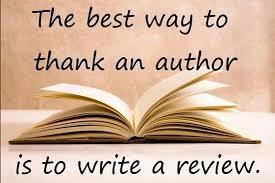Claudette Melanson's Blog - Posts Tagged "bookblog"
Reader Rally Cry! 4 Things You Can Do to Help the Authors You Love

Many of us love to read. I know I do! But what keeps that writer glued to their keyboard, oftentimes missing out on social outings or even getting to see the outside of the house—this is my life at most times—so that they keep producing the stories we most enjoy reading? Money? That isn’t what does it for me. Between my giveaways and the few trips I take to events, I make about six times less than I earn from my books. I believe most of us do it simply because we love the craft. I can’t imagine going for a terribly long span without creating my fictional worlds for my readers. I took a year off to try and build my editing business, but with the loss of my greatest passion, I found myself depressed and feeling much like a failure. That isn’t to say I don’t love helping my fellow authors to put their works out into the world; I’m just saying I was throwing myself waaaay out of balance. I’ve taken the last five months of my life and written in every spare moment available to me so that I could publish Riptide, the third book in my Maura DeLuca YA vampire trilogy. It did so much for my mental well-being, and I love writing for myself…but I still need the help of my readers, much in the same way I need to breathe or eat!
So, what can you do to help ensure your favorite authors keep writing? Here are just a few things:

1. Buy Their Books!
An article on The Guardian’s website states that the median income for any author is $5,000. Wow. How is anyone supposed to survive on that? I know mine is much less than that number, hence my need to keep my day job. You can help by supporting the author and buying their book. Don’t download from pirating websites…you’re taking food out of an author’s mouth, essentially. It’s really no different than walking into a bookstore and putting a book under your coat before walking out without paying for it. Think $4.99 or even $5.99 is too much for an Ebook? Consider that five months I put into Riptide, and the span was nine months for Undertow. What would you expect to be paid for working eight to ten hours four days out of seven for five months? Additionally, many would gladly hand over $5 to Starbucks—sometimes even daily—for a latte that takes three minutes to make. (I know I have!) That Ebook, which costs roughly the same, will provide you with enjoyment multiplied by several more of the minutes you spent downing that coffee! And the author put so much more time and money for things like a cover and editing into creating the book.

2. Leave a Review
For God’s sake, leave a review! Okay, I’ll stop being so heavy-handed, but a review is the best way to thank an author. It doesn’t have to be long-winded, either. A couple of sentences about what you enjoyed about the book, or even what you didn’t enjoy, will definitely suffice. I never realized myself how important reviews were to an author, but now that I do, I try to leave a review for every book I read. Most authors know about the magic number. In an article on The Huffington Post, point number three discusses the importance of fifty reviews on Amazon. Once a book hits fifty reviews, Amazon takes notice and will start making the book more visible on their site. Believe me when I say they are our lifeblood!
And just a note about book blogger reviews. Book bloggers, please, please, please stop excluding Indie Authors from your reviews, if you are one of the bloggers who do so. You are missing out on an avalanche of great books when you employ this rule. If you want the book to have a certain number of reviews on Amazon, so be it. But to refuse Indies entirely is blatantly unfair.

3. Buy Print Books on Createspace instead of Amazon
Createspace is basically Amazon. They provide the print copies of Indie Authors’ books to both the authors and to Amazon for distribution. If you buy the book on Amazon, the author makes about half the royalties they would had you bought the book from the Createspace store. Either way, you’re getting the same book at the same price, but you’re helping the author make more money. Click here: https://www.createspace.com/pub/simpl... to visit the store where you can search for the title or author you’re looking for. See the snapshot below. That is a comparison of what I make in royalties on Createspace vs. Amazon:

4. Help Authors Spread the Word and Engage
You may have seen authors posting about their books on Facebook and Twitter. You can help them out by engaging with them on social media too. Facebook will make posts more visible according to the likes, comments and shares a particular post gets. So, take that second as you’re scrolling down to like their picture, or even better, share it on your wall. Believe me, we appreciate it. Retweet their tweets on Twitter. Share posts on LinkedIn and plus one them on Google Plus. Like their Facebook pages and follow them on Twitter. Sign up for their newsletters so that you can help support them when they put out a new release or need a contest vote. So many of my readers have done this and I appreciate it so much!! Follow their Amazon Author Page. You can do this by clicking on their name at the top of any book’s page on Amazon. There is a rumor that Amazon offers you more visibility once you hit a certain number of follows, but I’m unsure as to whether that is true. And do you know about Goodreads? It is a site made for authors and readers. And one last mention—Facebook events. Make sure you attend the authors’ launches, cover reveals and parties. It’s all online, so can come in your jammies. They always give away awesome prizes, and I can promise you, the games are so much fun!

Thank you for reading and for supporting your favorite authors!

Website Resources:
https://www.theguardian.com/books/201...
http://www.huffingtonpost.com/brooke-...
Published on May 29, 2016 15:53
•
Tags:
authors, bookblog, books, claudette-melanson, reviews, social-media, support, writing
Escaping the Depths of Tell: Showing VS Telling for More Effective Writing

“Show me; don’t tell me,” my English professor quipped as she handed back my latest creative work, a flourish of bright red ink gracing the top of the page with a grade I found much less than desirable.
Learning to differentiate between showing and telling in my writing was a hard lesson to grasp during my early years as a writer. Luckily, I kept reading my weight in books over and over again as I practiced my craft. If Stephen King doesn’t provide a fine example of this technique over and over again, I don’t know who does. And I was lucky enough to find myself inside the classrooms of diligent and knowledgeable instructors, who were quite adept at teaching me the ins-and-outs of crafting a darned fine story. As an author today, I try my hardest to hold those lessons close, always endeavoring to hone and perfect my craft—and I will never stop trying to improve. As an editor, I strive to share anything I learn with my fellow authors. I’ve found that many struggle with the subject of this blog post and so hoped it might be useful to write up a post providing a couple of examples put into practice.
Showing in scenes of past action
I’ve read many scenes in which the author attempts to sum up actions occurring in the past, instead of flashing back to that point in time, giving the reader the opportunity to look through a magic window and watch the scene play out. It all comes down to adding adequate detail and expanding on one’s writing expertise so that the event is easily pictured in the reader’s mind. I’ll show you an example. The first scene will employ telling vs the second, which shows.
Telling-
When I was a little girl, Timmy bullied me horribly. He pulled pranks on me even his own friends found to be harsh and unnecessary. He tortured me with words as well as deeds, cutting me to the bone with his taunts. I couldn’t get him to stop, no matter how much I cried or pleaded. One day he did something horrible, and I found myself forced to stand up to him. I defended myself against his cruelty by fighting back, which actually brought the bullying to an end.
Showing-
During second grade, I attended school with a little boy, Timmy, who’d become my worst nightmare. He’d stood nearly one and a half times my size and doubled me in girth as well. His beady little green eyes had always found me the moment I’d stepped onto the playground at recess every day. With the shock of greasy black hair falling over one of his evil orbs, one might’ve wondered how his aim was so accurate when he landed punches against my jaw and square in the middle of my solar plexus. The hard-earned love of my teachers had become a handicap when Timmy had used it as a weapon against me. He’d taken great joy in dubbing me, “Lil Ass Kisser,” replacing my name with the term every time he’d caught sight of me. This had lead him to come up with taunts like, “Hey, Lil Ass Kisser, what’s that on your nose?” after which I’d found my appendage being shoved into the sticky mud. He’d forbidden me from washing the dirt away before we’d all returned to the classroom, causing my teachers to roll their eyes in exasperation and disbelief as they’d banished me to the boys’ washroom to make myself presentable…again. My mother had advised me to tell him how hurtful his actions were, but when I’d told Timmy his words and actions, “…really hurt my feelings,” he and his cronies had broken into fevered laughter before he’d told me, “I’ll show you what real hurt is, you slug.” That had been the day he’d dislocated my shoulder as he’d shoved my face into the earth. My tears hadn’t moved him to mercy in the least, as he’d left me wailing on the ground, so racked with pain I couldn’t move until the teacher had found me under the jungle gym outside, my face streaked by muddy tears and snot.
One day, I’d caught a caterpillar who’d been making his way along the rough bark of the massive oak tree at the edge of the playground. As he’d innocently inched along my finger, Timmy had snuck up behind me, slapping his hand down over mine and smashing my new friend into goo in the process. When I saw the green splatter of wasted innocent life dripping from my hand, something in me had snapped. I’d whirled in fury, crashing into Timmy so hard, he’d fallen instantly to the dirt. My eyes red with rage, I’d straddled him, beating his face with my tiny but effective fists until it had been transformed into a mess of bright blood sullied by caterpillar guts. Every time Timmy had focused those dull eyes on me in the future…he’d run in the opposite direction.
Which retelling would you whether read? Adding a few dry facts about a flashback is no match for providing vivid details which take the readers to the place where they can picture the events unfold inside their imagination.
Showing with dialogue
As a reader, and an editor, there’s nothing worse than when I see something like this when reading a text I’m deeply engrossed in:
Telling-
We told each other stories about all the Christmases we’d enjoyed the most. I told him about all my favorite presents and he described his most treasured to me. We told each other which carols we’d sung and about our most beloved foods at Christmas dinner. He described to me his most beloved memory of Christmas: the tree with all its ornaments passed down through the years, coupled with the enchanting colors of the strung lights, the same treasured memory as my own.
While endearing…this can be much improved upon.
Showing-
“What was your favorite Christmas?” I asked him, staring up into the light that was his eyes.
“The year I was six,” he answered, his eyes growing misty at the memory. “I’d asked Santa for a train set. One that would run upon its tracks when I pushed a button.”
“And you got one that year?”
“Yes,” he answered. “All I had to do was pop in a new set of batteries to see it race over the track whenever I desired.” He paused before gazing down at me with curiosity in his eyes. “How about you? What present did you love the most? What brought you the most excitement of any Christmas morning you can remember?”
“I was four.”
“Can you really remember back so far?” he asked, laughing.
“I can,” I assured him. “That was the year I found my first drum kit under the tree. I really can still remember the way my parents stuffed foam earplugs into their ears, still smiling to make me believe they loved the noise I made.”
“Now, those are good parents,” he told me, after his laugher had died away.
“Oh, they were,” I assented. “We used to sing “Jingle Bells,” the three of us, when they tucked me in on Christmas Eve.”
“It was always “We Wish You a Merry Christmas” in my family,” he said, a saddened smile playing across his face.
I wanted to erase the parts that weren’t happy in that expression of his. “Did you eat turkey and mincemeat pies?” I asked him.
“My family always ate ham. But my mother made the best pecan pies. Did yours?”
“The best sugar cookies,” I told him. I could feel the differences creeping in to separate us further. “I did love our tree,” I said, failing to see how anyone could refuse to cherish their own Christmas tree.
“That was always my favorite part of the holiday,” he revealed. “I used to lie beneath it and let the twinkle of all the colors carry me into sleep.”
“We have that in common,” I whispered. “I always did the same.”
See the difference again? Showing is always better than telling. Any writer can state facts… Can you make the details come alive with a flair that makes the reader forget their surroundings? Practice your own art of showing and work to perfect your skills as a writer.
Published on July 24, 2016 17:30
•
Tags:
authors, bookblog, books, claudette-melanson, reviews, social-media, support, writing



